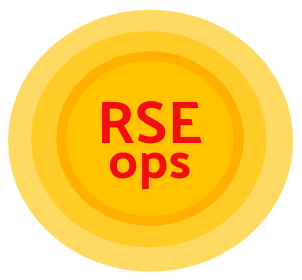
Containers for RSE-ops vs. DevOps
Containers are an essential tool for RSE-ops, as they are involved with continuous integration, software deployment and reproducibility, community standards, and testing. As an exercise to find opportunities for those in the DevOps and Rse-ops spaces to work together on tools or standards, we can look more closely at container technologies that are used in both spaces, and identify several use cases where this ample room for improvement and collaboration. A particular topic of interest for this exercise it looking at container metadata. There are currently no tools, standards, or best practices for definition and use of container metadata, and there are several use cases where it is badly needed. Ideally we could define a set of metadata that can solve use cases in both, and then tools and best practices around that. As was started with the containers working group here are several use cases that can be mapped to HPC or cloud with metadata that are needed for both. This kind of exercise can be extended to talk about more areas than just container technologies.
Use Case: Architecture and Host-aware Pulls
A user pulling a container from a registry to a host, regardless if we are on HPC or a cloud resource, should be able to get the best matching one. The container already exists, so we could imagine some hook before the pull looking at metadata on the host, and then sending it with a request for a specific container. This idea is similar to one discussed in [1]. In terms of metadata we would likely need:
Image architecture (to match to host) or best available for host per archspec
Hardware (and namely software compatibility with it)
Memory / resource needs (perhaps we can be more specific here) (an example that requires "big" nodes)
Software-level compatibility information (e.g., target CUDA driver version, MPI variant and version)
ABI info
For the above, it could be that there is a simple metadata matching algorithm, or something as complex as an actual solve. For this to work, the process of building images for different architectures needs to be made easier. A cluster would need to be able to create a listing of architectures present, and then issue those as requests to a build service or registry.
This use case is different from using an HPC scheduler one because the pull is happening from a node where it is intended to be run. Although the scheduler could also be given a container unique resource identifier to pull and then match it accordingly, the scheduler likely is given an unknown (already pulled) container, and needs to match it to a node.
Use Case: Container Discoverability
A user might want to quickly find a container that most closely matches what they need. This likely would be some kind of database that indexes metadata about containers, and provides it in a searchable interface. In terms of metadata this use case would likely need:
Software and libraries
Domain-specific labels
ABI compatibility about the container (to assess compatibility with the host)
Image architecture
Use Case: Dynamic Builds
A user on a resource should be able to navigate to a web interface, select a set of software or features desired for a container, and then have it built for use. This use case is slightly different because we are not searching for existing containers, but building custom ones. In terms of metadata, this use case would require:
Operating systems
Compatible package managers / software
Optimization
Several user groups are interested in being able to collect metrics about software and services. If containers could provide some of these metrics, it would help their use case. In terms of metadata this use case would likely need:
System and architecture details for where it was built
System and architecture details for where it has been successfully tested/run
For a limited scope of containers, such as those designed completely from a package manager, some of this metadata could be included automatically. However, most containers "in the wild" won’t have been developed from a single package manager, and there should still be a way to discover these metrics.
Use Case: Scheduler
A scheduler that is handed an unknown container should be able to quickly sniff it and be able to best match it to a node. Akin to Kubernetes, we would want to be able to match labels of nodes with labels of containers to be run there. For this use case, we would also need:
Image architecture
Hardware (e.g., ABI)
Memory / resource needs
- A. J. Younge, “A Case for Portability and Reproducibility of HPC Containers,” Sandia National Lab. (SNL-NM), Albuquerque, NM (United States), SAND2019-14107C, Nov. 2019. [bibtex]
